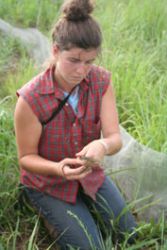 Drake University senior Elizabeth Hill examines a snake caught by one of her reptile traps at the Chichaqua Bottoms Greenbelt. |
CONTACT: Lisa Lacher (515) 271-3119,javascript:DeCryptX('2n2k3v0a1/3o2c3f3k1f1s1A3g2t0a2m2g1/2g0d2w')
With water up to their knees and sweat rolling down their faces, Drake seniors Elizabeth Hill and Hank Vogel carefully open the water trap to check the endangered ornate box turtle they caught. With turtle in hand, Hill and Vogel examine the reptile for distinguishing marks, set it free and then check the next trap.
Hill and Vogel are two of the student research assistants involved in the Drake University Undergraduate Science Institute summer research program, and have been studying these turtles at Chichaqua Bottoms Greenbelt along the Skunk River northeast of Des Moines. “I spend a lot of time setting traps so I can catch the turtles and then track their migration,” said Vogel, a resident of Sterling, Ill.
Nearly 30 Drake students and a high school student from Ames have the opportunity to conduct research projects alongside Drake faculty this summer.
“We are offering Drake undergraduates much more intensive work with faculty than they would get at a major research university, where most research assistants are graduate students,” said John Burney, dean of Drake’s College of Arts and Sciences.
DUSCI, which is in its first year, was made possible by a generous donation from Drake alumnus William Smith.
“The program has created a lot of excitement from students, and this is one of the things we wanted to do,” said Maria Bohorquez, director of DUSCI and associate professor of chemistry.
Students have the opportunity to work on projects ranging from the study of environmental estrogens to developing a science-based addition education program for high school students that uses video game development and virtual reality technologies.
“This is an amazing opportunity, and I am excited to be working with professor Summerville to study how animals start new populations in tall grass prairies,” said Drake senior Anson Bonte of Clermont, Iowa.
The work gives students the chance to learn and research outside the classroom.
“A student can only learn so much in the classroom, and these projects apply what I have learned in a variety of courses,” said Hill, a resident of Seattle, Wash. In addition to examining turtles, Hill conducts surveys to inventory small mammals, amphibians, reptiles, butterflies and plants at Whiterock Conservancy in Guthrie Country.
Professors are excited about the opportunity to offer students grants for working on groundbreaking research projects.
“Last summer I had to use my own grant to compensate my student research assistant. This summer the DUSCI program helped me with the grant for my research assistant,” said Charles Nelson, assistant professor of physics and astronomy.
Although DUSCI is only in its first summer at Drake, students are not only conducting field research, but also going on specialized trips to places such as the Great Ape Trust. “This is an added bonus to the program,” said Bohorquez. “Not only do students get their research experience, but they go on field trips and gain professional relationships with their professors.”
Research and scientific field trips are not the only aspects of the DUSCI program. Students have weekly lunches along with the faculty, where they discuss the progress they have made on their research projects during the week.
Students will be presenting their final research projects from 10 a.m. to noon Friday, July 28, in room 19B of Harvey Ingham Hall. The presentations will be on the findings of the research projects, and students will take questions based on their studies.
“We hope to continue this program for years to come, because of the large benefit it provides for our students,” Bohorquez said. “Our students are developing relationships with faculty, have the opportunity to publish their results and are performing research tasks through a program that is unique to Drake.”

